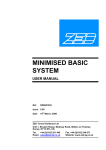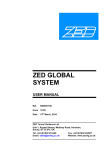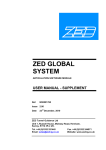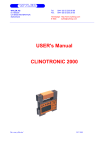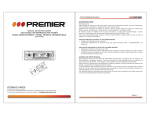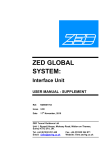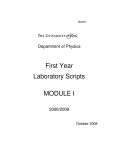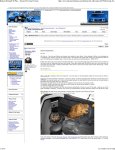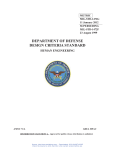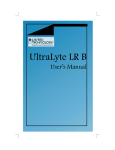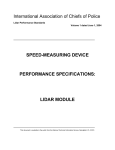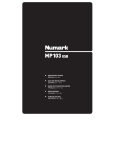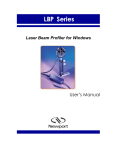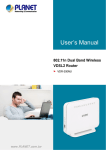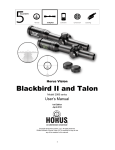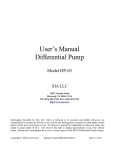Download 0001768 Basic User Manual v2, English
Transcript
BASIC SYSTEM USER MANUAL BASIC SYSTEM USER MANUAL Ref. ND0001768 Issue 2.00 Date 20th January, 2011 ZED Tunnel Guidance Ltd Unit 1, Russell House, Molesey Road, Walton on Thames, Surrey, KT12 3PJ, UK. Tel. +44 (0)1932 251 440 Email: [email protected] ND- 0001768 Basic User Manual v2: English Fax. +44 (0)1932 244 971 Website: www.zed-tg.co.uk Page - 1 - BASIC SYSTEM USER MANUAL ZED Tunnel Guidance Ltd 2009 The information in this document is confidential and the property of ZED Tunnel Guidance Ltd. It is released on condition that it shall not be disclosed to a third party without the prior written consent of ZED Tunnel Guidance Ltd. ND- 0001768 Basic User Manual v2 : English Page - 2 - BASIC SYSTEM USER MANUAL CONTENTS 1. INTRODUCTION 1.1 1.2 2. INSTALLATION 2.1 2.2 2.3 2.4 2.5 3. BACKGROUND A BRIEF DESCRIPTION OF THE SYSTEM GENERAL COMBINED TARGET UNIT JUNCTION BOX PROCESSOR DISPLAY UNIT CABLING SETTING UP 3.1 INFORMATION DISPLAYED BY THE SYSTEM 3.2 HOW THE SYSTEM FINDS ITS RESULTS 3.3 DISPLAYING DATA ON THE APPLICATION SOFTWARE 3.4 COMMISSIONING THE SYSTEM 3.5 SURVEY INFORMATION REQUIRED 3.6 CALCULATION AND SETTING OF VALUES 3.6.1 Present OFFSET X and Present OFFSET Y 3.6.2 Predicted OFFSET X and Predicted OFFSET Y 3.6.3 TARGET X OFFSET 3.6.4 LEAD STEPS 3.6.5 TARGET X and TARGET Y 3.6.6 BEAM X and BEAM Y 3.6.7 ZERO ROLL 3.6.8 ZERO LOOKUP 3.6.9 ZERO LEAD 3.6.10 GRADE 3.6.11 PREDICTION DISTANCE 3.6.12 LANGUAGE SELECTION 3.7 RECORDING PARAMETERS 3.8 CHECKING THE SETUP 4. INFORMATION DISPLAYED 4.1 MAIN VIEW – PRESENT POSITION 4.2 ROLL 4.3 LEAD AND LEAD 4.4 PREDICTED POSITION 4.5 GRAPHICAL VIEW 4.6 SPOT POSITION 4.7 MAIN VIEW – TOOLBAR 4.8 REFERENCE VIEW 4.9 HISTORY VIEW 4.10 MENU SYSTEM 4.10.1 UNIT SETUP 4.10.2 DOCUMENTATION – OPTIONAL SOFTWARE UPGRADE 4.10.3 SYSTEM CONFIGURATION 4.10.4 GUIDANCE DATA ND- 0001768 Basic User Manual v2: English - 5 - - 5 - - 6 - - 7 - - 7 - - 8 - - 10 - - 11 - - 14 - - 17 - - 17 - - 17 - - 18 - - 18 - - 19 - - 19 - - 19 - - 19 - - 19 - - 20 - - 20 - - 21 - - 21 - - 22 - - 22 - - 23 - - 23 - - 23 - - 23 - - 23 - - 24 - - 25 - - 27 - - 28 - - 29 - - 30 - - 31 - - 32 - - 33 - - 34 - - 35 - - 36 - - 39 - - 42 - - 45 - Page - 3 - BASIC SYSTEM 5. OPERATION 5.1 5.2 5.3 5.4 6. USER MANUAL USE BY THE MACHINE OPERATOR MOVING THE TARGET THE ENGINEER’S OR SURVEYOR’S USE OF THE SYSTEM USING OFFSETS MAINTENANCE 6.1 REGULAR CHECKS 6.1.1 COMBINED TARGET UNIT 6.1.2 CABLES and CONNECTORS 6.2 OVERAHAULS 6.3 TOOLKIT 7. TROUBLESHOOTING 8.1 ERROR MESSAGES 8.2 DIANOSING FAULTS 8.3 FAULT CORRECTION 7.3.1 COMBINED TARGET UNIT 8.4 USING THE LASER POWER METER 8.5 CONTACTING ZED TUNNEL GUIDANCE LTD 8.6 PART NUMBERS APPENDIX A - 49 - - 51 - - 52 - - 53 - - 57 - - 57 - - 57 - - 57 - - 57 - - 58 - - 59 - SETTINGS 7.1 MEMORY STICK FUNCTIONS 7.2 PAUSING THE GUIDANCE SYSTEM 7.3 PDU BACKUP AND RESTORE 7.3.1 PDU BACKUP 7.3.2 PDU RESTORE 8 - 49 - - GLOSSARY ABBREVIATIONS ANGULAR UNITS BEAM POSITION GRADE INCLINOMETER LASER LASER POSITION LEAD DIFFERENT TYPES OF LEAD LEAD STEPS LOOKUP MACHINE REFERENCE PLANE OFFSETS PREDICTED POSITION PRESENT POSITION ROLL SPOT POSITION TARGET POSITION COMBINED TARGET UNIT ZERO LEAD ZERO LOOKUP ZERO ROLL APPENDIX B RECORD SHEET ND- 0001768 Basic User Manual v2 : English - 60 - - 61 - - 62 - - 62 - 63 - 67 - - 67 - - 68 - - 69 - - 69 - - 70 - - 71 - - 72 - - 73 - - 73 - - 74 - - 74 - - 74 - - 75 - - 75 - - 75 - - 76 - - 76 - - 77 - - 78 - - 78 - - 79 - - 80 - - 81 - - 82 - - 82 - - 83 - - 84 - - 84 - - 85 - - 85 - - 87 - - 87 - Page - 4 - BASIC SYSTEM USER MANUAL 1. INTRODUCTION 1.1 BACKGROUND The first tunnel guidance system from ZED Tunnel Guidance Ltd was manufactured in 1977. Since then continuous development has resulted in a comprehensive range of computerised guidance systems that are now in use throughout the world. This work has resulted in ZED Tunnel Guidance Ltd receiving the Queen's Award for Technological Achievement in 1986 and the Queen's Award for Export Achievement in 1987 and 1991. A range of systems are currently produced to cater for different levels of tunnel complexity. The systems in this range all have certain standard items and common features. The range at present consists of the following: : A basic system, normally used in straight tunnels but with some capacity for curves. Combined Target and separate application software Minimised Global : An intermediate system. Combined Target and separate application software. Curves are preprogrammed within the application software. Basic : A basic system, normally used in straight tunnels but with some capacity for curves. Combined Target and Processor Display Unit Global : Intermediate core system. Curves are pre-programmed within the Processor Display Unit. Combined Target and Processor Display Unit Upgraded Global : A series of more advanced configurations based on the Global System.. A suite of upgrades and additions available to meet specific project demands i.e. Ring Sequencing, compensating for an articulated / double shielded machine, EtherNet IP links to PLC’s & remote PC’s, etc. Minimised Basic (Minibasic System) The purpose of the ZED tunnel guidance system is to provide the user with details of the tunnelling machine's deviations from its planned route so that corrections can be made quickly. This should enable a highly accurate tunnel to be built with increased speed and at a lower cost. ND- 0001768 Basic User Manual v2: English Page - 5 - BASIC SYSTEM USER MANUAL 1.2 A BRIEF DESCRIPTION OF THE SYSTEM The equipment works by calculating the position of the machine based on a beam from a laser at a fixed point. By knowing the position of the machine it can then calculate its deviation from the planned route of the tunnel. This information is then displayed on various views of the application software contained on a rugged computer. This is normally placed close to the machine operator's control console so that the operator can use the information to guide the machine. The software application also stores and allows input of the information needed by the system. To measure the machine's position, a unit containing sensors is used, known as the Combined Target Unit. An optical array in this unit measures the point at which the laser beam hits it and also the angle of incidence of the beam. An inclinometer transducer in the unit measures the angle of rotation of the machine in two directions. ND- 0001768 Basic User Manual v2 : English Page - 6 - BASIC SYSTEM USER MANUAL 2. INSTALLATION This section describes the positioning and connection of the units of the ZED system on the tunnelling machine and elsewhere. 2.1 GENERAL For the Basic System there are three units mounted on the machine, the Combined Target Unit, the Junction Box, and the Processor Display Unit. These units should be placed in a position where they will not be damaged by movement of machinery, heat, hydraulic fluid, large amounts of water, etc. Fix the units as firmly as possible, to solid parts of the machine, using the fixing holes and anti-vibration isolators provided. Do not weld the unit directly to the machine. Always ensure that there is enough room for the cable to be connected to the unit. ND- 0001768 Basic User Manual v2: English Page - 7 - BASIC SYSTEM USER MANUAL Fitting of the units may require plates or brackets to be welded to the machine. Do not carry out this welding with the ZED equipment already fixed to the plate or bracket. In general the Combined Target Unit is usually mounted at the top (or top left/top right) of the shield area. If the sections ahead of the target can articulate then the ZED system will not show the correct position of the cutter head unless more equipment (an Articulation Interface Unit and associated transducers) is added to the system. In all cases it is helpful if the machine has been designed with the knowledge that a ZED system is to be used on it. 2.2 COMBINED TARGET UNIT The Target Unit must be placed in such a position that the laser beam will strike the front screen continuously. This means that it is preferable if parts of the machine, such as the erector, cannot obstruct the path of the laser and the area around the path of the laser should be as large as possible. The Target Unit will normally be mounted towards the crown of the tunnel in order to minimise interruptions by persons working in the tunnel. If the TBM is articulated then the Target Unit should be mounted on the front part of the machine otherwise additional equipment will be required in order the monitor sections ahead of the Target. The Target Unit may not function correctly if bright light sources other than the laser are visible from its viewpoint. It is therefore useful to mount the unit in a darkened part of the machine or to shield it from direct light sources. The operation of the unit will also be impaired if the screen is allowed to become dirty so that a periodic wipe with a damp cloth may be advisable in very dusty atmospheres. When the system is to be used in tightly curved tunnels then the laser beam will tend to move across the Target screen as the TBM progresses and the laser must be adjusted to a new position periodically. To minimise this problem it is possible to mount the Target Unit on a sliding bracket. This allows the Target to be moved horizontally so that if the laser spot is to the side of the Target it can again be made to hit the screen. Movement along this bracket should be adjustable by 50 mm steps to allow use of the related software facilities. Should the angle that the laser beam hits the Target exceed five degrees it is necessary to rotate the Target Unit on a more complicated rotating bracket (also available from ZED Tunnel Guidance). Movement on this bracket is adjustable in three degree steps. Having selected the best position for the Target Unit it must be mounted within the following limits: Roll Look-up Lead ND- 0001768 Basic User Manual v2 : English ± 0.5° to the vertical machine axis ± 0.5° to the principal machine axis ± 0.5° to the principal machine axis Page - 8 - BASIC SYSTEM USER MANUAL Active screen area for centre of spot before the out of limits error, #, is given: X = ± 60mm Y = ± 47mm Lead angle of laser beam = ± 90 mm/m (approximately ±5.2°) ND- 0001768 Basic User Manual v2: English Page - 9 - BASIC SYSTEM USER MANUAL 2.3 JUNCTION BOX This small rugged unit is normally placed near to the Processor Display Unit. Access to this unit is not too important except to aid in replacing any damaged cables so positioning of the unit is not critical. ND- 0001768 Basic User Manual v2 : English Page - 10 - BASIC SYSTEM USER MANUAL 2.4 PROCESSOR DISPLAY UNIT The Processor Display Unit must be placed within easy reach and view of the operator. The viewing angle is not critical, but the amount of light reflected from the display may make viewing difficult. Protect the unit from water spray, dust, mud and mechanical damage and allow easy access to the connectors. The unit can be mounted either on a panel or within a panel by reversing the mounting brackets to the appropriate orientation. ND- 0001768 Basic User Manual v2: English Page - 11 - BASIC SYSTEM ND- 0001768 Basic User Manual v2 : English USER MANUAL Page - 12 - BASIC SYSTEM USER MANUAL Depending on the version of Processor Display Unit, the Processor Display Unit either automatically powers on when power is first applied, or the unit is in standby mode and will need to be powered on by holding in the power push button for a short while. Standby mode is indicated by two short flashes of the red LED (contained within the power push button) followed by a long pause. On powering up the unit goes through an initialisation period before completely powering on, ready for use. This initialisation period is indicated by an equal interval flashing red LED button. This LED will become constant once the initialisation sequence has finished. Subsequently the PDU can be turned off and on by holding the power push button. ND- 0001768 Basic User Manual v2: English Page - 13 - BASIC SYSTEM USER MANUAL Below the power push button are another two that can be used to vary the intensity of the display brightness. Pressing + increases the brightness and pressing – decreases the brightness. It incorporates a rugged touch screen for user interaction. A USB mouse located in the toolbox is available if required. Above the push buttons is a small window that contains the status indicator LED's and these are detailed in the following diagram: The red power LED’s indicate the status of the power for each supply. Each port has two LED indicators associated with it, the , indicates that data is being received to the port and the , that data is being sent from the port. The top connector at the side is the USB port. The middle connector at the side is an Ethernet port. The connector port on the front panel (bottom right) is used for diagnostic purposes only. 2.5 CABLING Having decided on the best location for the unit it is then necessary to choose the cable lengths to suit the arrangement. The lengths chosen should be not too short (to avoid making sharp bends) but not too long (to avoid coils of unnecessary cables). The cable supplied by ZED Tunnel Guidance Ltd to connect between the unit and the computer will already have the connectors fitted at each end. This will mean that running the cables through small holes is not possible unless the connectors are dismantled. ND- 0001768 Basic User Manual v2 : English Page - 14 - BASIC SYSTEM USER MANUAL Each cable is identified by labelling on a yellow sleeve which names the two units that are joined by the cable. The sockets on each unit are similarly named with the unit to which they connect. The cables and connectors should be protected by careful siting and by anchoring them, wherever possible, to the permanent structure of the machine. Make sure cables do not trail on the floor and avoid sharp bends, fatigue and excessive heat. Keep all connectors clean and dry. If cables must span areas where they cannot be fixed then attempt to provide protection from snagging. Do not allow cables to be used as hand or foot-holds for climbing. ND- 0001768 Basic User Manual v2: English Page - 15 - BASIC SYSTEM ND- 0001768 Basic User Manual v2 : English USER MANUAL Page - 16 - BASIC SYSTEM USER MANUAL 3. SETTING UP The purpose of this section is to provide a basic understanding of how the system works. It also describes the information needed before the system can be put into operation. 3.1 INFORMATION DISPLAYED BY THE SYSTEM All data that the system calculates or measures is supplied to the machine operator in the form of numbers and graphical views by the application software on the computer. The information displayed can be changed by use of the pushbuttons on the display. When this is done to display a different set of information we say that a different "view" has been selected. On a Basic System the operator has access to two views of information.. Full details of these views are given in Section 4 but the following summarises the information given. The main view shows the distances, in a horizontal and vertical direction, of the centre of the machine from the centreline of the tunnel as designed. One of these shows this for the part of the machine where the Combined Target Unit is mounted, the other for a certain distance ahead of this (usually the cutterhead or just in front of the cutters). Also angular movement of the machine, i.e. Roll, Lookup and Lead, and the point where the laser beam hits the target screen. To summarise, most of the information displayed by the main view shows the difference between where the machine should be and where it is. How this information is used by the operator is explained in Section 5. 3.2 HOW THE SYSTEM FINDS ITS RESULTS To be able to show the position as described above, the software application requires information to be input by both the sensors and the user. The basis for its calculations are the position and angle of the laser and the designed tunnel path (specified by offsets from a straight line). During installation of the system certain measurements are entered into the application software to inform it of the position of the Combined Target Unit relative to the axis of the machine. Using the above user-supplied information the application software takes data from the sensors to calculate the position of the machine. The inclinometer transducer in the Combined Target Unit transmits to the application software the Roll and Lookup of the machine. The Combined Target Unit also detects the position of the laser beam where it hits the screen. From the information above it then calculates the actual position of the centre of the machine in the plane of the screen of the ND- 0001768 Basic User Manual v2: English Page - 17 - BASIC SYSTEM USER MANUAL target. It is then a simple calculation to find and show the deviation of this position from the designed position. This is the Present Position. The Combined Target Unit also measures the angle of incidence of the laser beam (that is the angle with which the beam hits the screen compared with the centreline of the Combined Target Unit). This can be used to provide the Predicted Position, which is the difference between the actual and the designed positions of the machine at the front of the machine. The distance between the present and the predicted positions is called the Prediction Distance and is set in the set-up view. 3.3 DISPLAYING DATA ON THE APPLICATION SOFTWARE When the application software is first turned on the display will show the main view. This is subdivided into a central display which is surrounded by eight smaller views. Each of the smaller displays, except the Present & Predicted Offsets, can be selected to open centrally with a larger format. 3.4 COMMISSIONING THE SYSTEM Very often the first time a system is installed the commissioning is carried out by the staff of ZED Tunnel Guidance Ltd. This manual however assumes that the user may wish to recommission the system without assistance. It is also recommended that this section be read anyway because it contains full details of the secondary pages displayed. The best time to commission the system is a few days before tunnelling is to start. This gives enough time to correct any faults which may be detected. Obviously all of the hardware must be installed and properly fitted in its correct position before commissioning can begin. The laser must be installed and working at the time of commissioning. To carry out the commissioning work the machine must be stationary for a period of several hours. It is also better if the machine is close to level although this is not so important. For the ZED System it is also easier if the machine is in a straight section of tunnel. The machine manufacturer can make the setting up procedure easier by clearly indicating the horizontal and vertical axes of the machine. If this has not been done it may be necessary to measure and make these marks. ND- 0001768 Basic User Manual v2 : English Page - 18 - BASIC SYSTEM USER MANUAL 3.5 SURVEY INFORMATION REQUIRED The following data must be accurately measured and the required data fed into the application software. Some of these values will not change when the machine moves but others will. The things that remain constant can be entered before the others to save the amount of time the machine must remain still. The data required is: a). b). c). d). e). 3.6 The Roll and Lookup of the machine. The distance of the centre of the Combined Target Unit screen from the horizontal and vertical axes of the machine. The terms horizontal and vertical refer to the machine as designed (i.e. as if it had no Roll). The distance of the centre of the laser beam from the designed tunnel centreline. Note that the laser beam must be aligned parallel to the designed tunnel centreline. The Grade (or slope angle) of the designed tunnel. The actual position of the machine. This means finding out the angle of the Principal Machine Axis relative to the laser beam. CALCULATION AND SETTING OF VALUES This section describes the calculations necessary to find the values to be entered into the application software. If at any time during the setting up procedure an error message such as LIGHT ( * ) or TRANSMIT ( ~ ) appears on the application software views then there is a problem. Troubleshooting is described in Section 7. Until setting up is complete errors indicated by OUT OF LIMITS ( # ) should be ignored. If at this stage the equipment is fully assembled, powered and otherwise ready, but there is no obvious fault then please refer to Section 7 or telephone ZED Tunnel Guidance Ltd for assistance. 3.6.1 Present OFFSET X and Present OFFSET Y These are the present position offset values that tell the system that the tunnel is not straight. They are found on the main view and the ref view. If the tunnel is straight these values are both zero. If the tunnel is curved then offset values at this point must be calculated. Please refer to Section 5.4 for information on how to do this. 3.6.2 Predicted OFFSET X and Predicted OFFSET Y These are the predicted position offset values that tell the system that the tunnel is not straight. They are found on the main view and the ref view. If the tunnel is straight these values are both zero. If the tunnel is curved then offset values at this point must be calculated. Please refer to Section 5.4 for information on how to do this. 3.6.3 TARGET X OFFSET ND- 0001768 Basic User Manual v2: English Page - 19 - BASIC SYSTEM USER MANUAL The set-up view allows for the movement left or right of the Combined Target Unit along a support beam. This is to let the laser beam hit the target for longer without the laser itself being moved. The movement on the beam is set in 50mm steps. If such a support beam is being used then one position must be selected as a starting point. If the target is moved to the left of this point then the TARGET X OFFSET becomes negative. If the target is moved to the right then the value becomes positive and larger. Movement of the target on the beam is not automatic. Changing the value on the application software does not move the Combined Target Unit. 3.6.4 LEAD STEPS This value, on the set-up view, performs a similar function to TARGET X OFFSET. In this case the change allows for the target to be rotated in 3° steps from a central zero value. Changing this value is done in the same way as for TARGET X OFFSET 3.6.5 TARGET X and TARGET Y The TARGET X and TARGET Y (collectively known as the target co-ordinates) values specify the position of the target as mounted on the machine. These values are measured relative to the axes of the machine and are not dependant on the attitude of the machine at the time of measuring. TARGET X is the distance measured along a line parallel to the left/right centreline of the machine between the centre of the screen of the target and the up/down centreline of the machine. Positive values are for positions to the right of the up/down axis. Similarly TARGET Y is the distance measured parallel to the up/down axis of the machine from the centre of the target screen to the left/right axis. Positive values are for positions above the left/right axis. The values in millimetres are entered on the set-up view by selecting the required display value and entering the new number in the numerical keyboard that appears and pressing enter to confirm. ND- 0001768 Basic User Manual v2 : English Page - 20 - BASIC SYSTEM USER MANUAL Fig 3-1 Target co-ordinates 3.6.6 BEAM X and BEAM Y On the ref view beam X and Y specify the position of the laser relative to the centreline of the designed tunnel. BEAM X is the horizontal distance to the Laser and BEAM Y is the vertical distance. When viewed looking from the laser to the machine, X is positive to the right of centre and Y positive above the centre. The value is entered in millimetres. Fig 3-2 Beam X and Y 3.6.7 ZERO ROLL ND- 0001768 Basic User Manual v2: English Page - 21 - BASIC SYSTEM USER MANUAL This value can be measured only if the Combined Target Unit is properly mounted and the application software is operational and connected to it.. The Roll of the machine must be measured using normal surveying methods. The purpose of the ZERO ROLL value is to compensate for any inaccuracies in the mounting of the inclinometer transducer. The Combined Target Unit will measure a Roll value (referred to as Raw Roll) which will probably differ from the actual Roll. The ZERO ROLL is the value that when added to the Raw Roll yields the actual Roll. All Roll values are measured in terms of the number of millimetres displacement of a plumb line one metre long. A positive value indicates clockwise rotation as viewed from the laser. Having measured the actual Roll of the machine, look at the roll display on the setup view. The Roll Zero value box should be altered so that the number on the roll display equals the actual Roll of the machine. For example if the Zero Roll value is initially 0, the value on the roll display 12, and the actual value is 18, then the zero value should be changed to 6. 3.6.8 ZERO LOOKUP This value also relates to the Combined Target Unit and is in many ways similar to ZERO ROLL. Lookup is the measurement of how level the machine is (as viewed from the side). A positive Lookup means that the front of the machine is higher than the rear. It is measured in millimetres per metre. Entry of the value on the set-up view is made in the same way as ZERO ROLL. 3.6.9 ZERO LEAD Care must be taken when setting the ZERO LEAD value. Confusion arises because of the use of the name Lead for a variety of different values. The ZERO LEAD setting is used to compensate for the inaccuracy of mounting the Combined Target Unit on the machine. What is required is that when the machine is exactly parallel to the laser beam then the value displayed in the Lead to Laser display is zero. To set the ZERO LEAD we therefore need to know the angle between the Principal Machine Axis and the laser beam. Before setting ensure that the Combined Target Unit is correctly mounted and if a rotating bracket is used then check that it is centralised (i.e. LEAD STEPS=0). By converting the angle between the Principal Machine Axis and the laser beam into a tangent expressed in millimetres per metre we can find the value which should appear on the application software. This value is the Lead to Laser. Changing the ZERO LEAD value on the set-up view the displayed Lead to Laser value. When the displayed Lead to Laser value equals the measured value the ZERO LEAD value is set. Lead to Laser is positive if the laser beam would cross the Principal Machine Axis going from right to left (as it heads towards the front of the machine). That is the machine is heading right relative to the laser direction. ND- 0001768 Basic User Manual v2 : English Page - 22 - BASIC SYSTEM USER MANUAL After some time, and tunnelling for a distance of 50 to 60 metres or more, it may become apparent that the movement of the machine differs from that indicated by the guidance system. This can occur because tunnelling machines do not always move in a direction parallel to their own principal axis. Minor modification of the Zero values can counteract this difference. 3.6.10 GRADE Displayed on the ref view is used to specify the GRADE of the laser. This is the angle that the laser is set relative to horizontal. It is measured in millimetres per metre. Positive values mean that the laser is pointing uphill. Normally this Grade is the same as the grade of the tunnel but this is not the case when the tunnel is curving in a vertical direction. If the tunnel curves then offsets must be used but the Grade remains the angle of the laser. 3.6.11 PREDICTION DISTANCE This value, which is entered as a number of millimetres on the set-up view, specifies the distance from the Machine Reference Plane (or Present Position Plane) to the Predicted Position Plane. Usually this is set so that the Predicted Position is shown for a point slightly ahead of the cutters at the front of the machine. The exact value used is chosen by the user. 3.6.12 LANGUAGE SELECTION At present only English is available 3.7 RECORDING PARAMETERS Normally the application software will retain the set-up information. However should a fault develop the initial settings may be lost. To avoid having to remeasure the parameters we recommend recording them whenever they are changed. A suitable form is provided in Appendix B. 3.8 CHECKING THE SETUP Checking that all the correct parameters have been entered is a useful procedure but one which can only be done if the actual position of the machine is known. The measurements needed to find the position of the machine are not complicated but we cannot explain how to do them here because they differ from one particular machine to another. Section 4 explains the meaning of the main view and are the ones that should be used to check whether the parameters are correct. Compare the surveyed position of the Present Position, Predicted Position etc. with the calculated values to see if ND- 0001768 Basic User Manual v2: English Page - 23 - BASIC SYSTEM USER MANUAL there is any discrepancy. If an unacceptable difference is found then the parameters should be rechecked. 4. INFORMATION DISPLAYED The application software has two views. (See Section 3.1 for the difference between views.) The main view is used to show the operator the position of the machine thus enabling the operator to steer the machine in order to keep it on course. ND- 0001768 Basic User Manual v2 : English Page - 24 - BASIC SYSTEM USER MANUAL Each numerical display on the right hand side has four positions in which to show values, The bottom message line shows the application title and software version. The four value positions are arranged so that positive values are at the top or right and negative values are at the bottom or on the left. The meaning of each value is explained below. If a number has an error symbol and the box outline is red then there is an error. You should not continue to steer the machine on the basis of numbers that are displaying errors NOTE For each of the sections below an example of the application software display is shown. To explain this a diagram showing the position of the machine is given. These diagrams are not to scale and the angles and positions are very exaggerated. 4.1 MAIN VIEW - PRESENT POSITION The PRESENT POSITION display indicates how far off course the machine is. This is measured in the plane of the target screen. The values indicate the distance horizontally and vertically from the centreline of the designed tunnel to the centreline of the machine (the principal axis). To express this in a different way, imagine that the surface of the screen of the Combined Target Unit is expanded in all directions and marks made on this surface to indicate the centre of the machine and the centre of the designed tunnel. If lines are now drawn vertically and horizontally that pass through the centre of the tunnel ND- 0001768 Basic User Manual v2: English Page - 25 - BASIC SYSTEM USER MANUAL marker, it is then possible to measure the distance from these lines to the centre of the machine point. The display on the main view should have two values shown on it. One will be to the left or right of the centre and the other above or below the centre. If the centre of the machine is to the left of centre of the designed tunnel then the distance is shown on the left hand side of the display. We say that this is a Negative X Present Position. Negative means it is on the left and X indicates horizontal measurement. The value shown is the actual distance in millimetres. Negative values are shown on the left and do not have a minus sign () attached to them. A value shown on the right of the dsiplay is positive and means that the machine is further to the right than it should be. Similar rules apply for the vertical direction. A value shown at the top of the display is positive and indicates how far too high the machine is. A value shown at the bottom of the display shows how far too low the machine is. We say the value is negative if the machine is too low. Vertical positions are the Y Present Positions. Fig 4-1 Present Position (exaggerated angles) Machine is shown pointing up and to the right Example In this example the number 1 is shown on the left of the screen. This means that the machine is 1mm left of where it should be. The number 14 is shown at the top. This means that the machine is 14mm higher than its desired position. ND- 0001768 Basic User Manual v2 : English Page - 26 - BASIC SYSTEM USER MANUAL 4.2 ROLL Roll is the rotation of the machine about its own principal axis (The axis running from the rear to the front of the machine). This is measured with respect to gravity. The units are millimetres per metre. If a one metre long plumb line were hung from the centre of the machine then the distance that it swung away from the machine's vertical axis would be the Roll. The machine's vertical axis is one defined at manufacture or some other time and is not referenced to gravity. On the display there are two values. The Roll value can be either on the left or the right of the display. If it is on the left then it indicates that the machine has rolled anticlockwise as viewed from the laser. This is negative Roll. Clockwise (or positive) Roll is shown on the right. Fig 4-2 Roll (exaggerated angles) Example In this example the number 7 is shown on the right of the screen. This means that the machine has rotated 7mm/m in the clockwise direction. This is also indicated by the yellow triangle which moves left and right as the machine rolls. ND- 0001768 Basic User Manual v2: English Page - 27 - BASIC SYSTEM USER MANUAL 4.3 LEAD AND LOOKUP Lookup is the name given to the measurement of the tilt of the machine from front to rear. It measures by how much the front is above or below the rear. The Lookup value is quoted in terms of millimetres per metre. If the machine is going uphill then the Lookup is positive, if it is going down then the value is negative. To make this easy to interpret on the display the values are shown at the top of the Roll/Lookup display if the machine is going up, and at the bottom if it is going down. A negative Lookup value corresponds to the tunnelling term "Overhang". Lead is the name given to the measurement of the direction of the machine in the horizontal plane relative to the laser. If the machine is moving towards the left then the value (expressed in millimetres per metre) is shown on the left of the display. If the machine is heading to the right then it is shown on the right. If the tunnel is straight and parallel to the laser then the Lead indicates the direction of the machine relative to the tunnel. If the tunnel is curved then this is not necessarily the case. The term Lead is explained in more detail in Appendix A. Fig 4-3 Lead and Lookup (exaggerated angles) Machine is shown pointing DOWN and to the LEFT Example In this example the number 14 is shown on the left of the Lead display. This means that the machine is veering to the left at a rate of 14mm for every metre pushed. The number 26 is shown at the top of the roll/lookup display. This means that the machine is heading uphill at the rate of 26mm for every metre pushed. ND- 0001768 Basic User Manual v2 : English Page - 28 - BASIC SYSTEM USER MANUAL 4.4 PREDICTED POSITION The information shown on the PREDICTED POSITION page is similar to the PRESENT POSITION. The difference is that the values refer to the position for a plane passing through the machine ahead of the Present Position Plane. In fact this Predicted Position Plane can be ahead of the machine. The values shown on the display indicate the distance from the designed tunnel centre to the machine centre in this Predicted Position Plane. Fig 4-4 Predicted Position (exaggerated angles) Machine is shown pointing DOWN and to the LEFT The purpose of this information is to indicate how far off course the front of the machine is. If the Predicted Position Plane is ahead of the machine's cutters then the machine can be moved to rectify an error before it becomes too large. Hence the "Predicted" name. A general idea is to steer the machine so that the values on the Predicted Position page are as small as possible (i.e. close to zero). The distance between the Present and Predicted Position planes is specified by the Prediction Distance setting. ND- 0001768 Basic User Manual v2: English Page - 29 - BASIC SYSTEM USER MANUAL Example In this example the number 28 is shown on the left of the screen. This means that, at the prediction distance ahead of the target, the machine is 28mm left of where it should be. The number 59 is shown at the top. This means that, at the same distance ahead of the target, the machine is 59mm higher than its desired position. Obviously as shown in the diagrams the machine does not extend as far as the distance given by the Prediction Distance. This means that the value given is a prediction of where the machine would be if no course correction was applied. The machine is rolling clockwise at 7mm/m. If we assume that no offsets are being used and that all five examples given in this section apply at the same time then we can see the correlation between the results. On the present display the position is 1mm left, on the predicted display it is 28mm left. This means that the machine is heading left. If we further assume that the Prediction Distance is 2 metres then we calculate that the machine is heading left at a rate of ((-28)+1)/2 mm/m which is -13.5mm/m. This is the LEAD shown as -14mm/m. Similarly we can calculate the LOOKUP as ((+59)-14)/2 which is 22.5mm/m. The lookup of the target unit shown is 26mm/m which equals the calculated lookup, 22.5, plus the desired tunnel grade, which in this example is set to 3.5mm/m. 4.5 GRAPHICAL VIEW This display shows a graphical representation of the present and predicted position. The colours of the circles correspond to the colour of the text used for the positions, i.e. blue for present position and green for predicted position. The roll of the machine is also indicated by the circles being drawn at the roll angle. The small solid circle indicates the top of the machine and the scale in the bottom right corner shows the distance each mark on the axes corresponds to. The icon in the top left corner indicates that the display mode of this information box can be changed; note that this icon is only displayed when viewed in the central box. Pressing the change mode icon toggles the display to the one shown on the left. The top half shows the horizontal ND- 0001768 Basic User Manual v2 : English Page - 30 - BASIC SYSTEM USER MANUAL offsets for both the present and predicted positions. These points are joined with a line to indicate the horizontal angle of the machine. The bottom half shows the vertical offsets and they are joined by a line to indicate the vertical angle of the machine. This display is drawn with a fixed scale capable of showing up to ±200mm horizontal offset and ±100mm vertical offset. Values larger than this will not be shown. 4.6 SPOT POSITION This display simply shows the position of the centre of the laser beam spot where it hits the Combined Target Unit screen. The centre of the screen is the origin. If the spot is left of the centre the value (in millimetres) is shown on the left of the page. If the spot is at the top it is shown at the top of the page and so on. The reason for showing this information is so the user can check that the spot remains on the target screen. If the spot position moves to the far edge of the screen then the Combined Target Unit or laser should be moved to compensate. The information obtained from the Combined Target Unit is more accurate when the beam hits the screen near the centre. As the spot position moves to the edge the accuracy, especially of the Lead measurement, diminishes. Fig 4-5 Spot Position (not to scale) Example In this example the number 1 is shown on the left of the screen. This means that the laser beam is hitting the target screen 1mm to the left of its centre. The number 16 is shown at the bottom. This means that the laser beam is hitting the target screen 16mm below its centre. ND- 0001768 Basic User Manual v2: English Page - 31 - BASIC SYSTEM USER MANUAL 4.7 MAIN VIEW – TOOLBAR Symbol Description Green All device communication is working. Red Some device communication is failing. Blue Simulation is active. Yellow Software is not operational. Green All data is valid. Red At least one data item is in error. Blue Test mode is active. Comms DATA Main View Reference View History View (optional) Perform a manual log. (optional) Print the data currently being viewed. (optional) This menu icon in the top left corner provides access to the menu pages where configuration data is stored. This clock icon in the top right corner provides access to a dialog box to allow the user to update the software or set the system time. It also provides contact information for ZED Tunnel Guidance. ND- 0001768 Basic User Manual v2 : English Page - 32 - BASIC SYSTEM USER MANUAL 4.8 REFERENCE VIEW The reference view displays the current offset at both the present and the predicted position plane. Also the X and Y co-ordinates of the laser beam along with its grade are shown. The blue border around these values indicates that they can be edited by clicking the individual value boxes. A keypad will appear next to the selected value allowing numerical input. These values are also editable through the menu pages. If a security pincode has been set then these values will only be editable on the menu pages. ND- 0001768 Basic User Manual v2: English Page - 33 - BASIC SYSTEM USER MANUAL 4.9 HISTORY VIEW The optional history view allows the user to view previously logged data. This logged data is viewed using the same two views as the current machine position data. The History views are obtained by pressing the HISTORY VIEW. History view is indicated by blue borders around each display ( if they do not contain errors ), the time and date are highlighted and a block of selection buttons are displayed. The logged data is stored in dated files, such that the data for a full days logging is all stored in one file whilst the logged data for the previous day is stored in a separate file. ND- 0001768 Basic User Manual v2 : English Page - 34 - BASIC SYSTEM USER MANUAL To view the different sets of logged data you can use the single left or right arrows on the bottom button bar.To jump to the previous or next days logged data you can press the double arrow. The other views can be selected whilst in history mode. The icon between the bottom button bar arrows depicts what type of log the data represents. Either a icon to indicate that the data was logged by a manual press of the LOG button or a icon to indicate that the data was automatically logged by a time interval. 4.10 MENU SYSTEM The menu system allow the user to configure the system , view all system values and transfer any logged data files to a removable device. Pressing the menu button normal views. toggles between the menus and the The following menus are available: Vertical Menu Unit Setup Horizontal Sub-Menu System Data System Views System Installation System Security Documentation Log Options Log Transfer Log History Options Log Print Options System Configurations System Connections Comms Viewer ND- 0001768 Basic User Manual v2: English Page - 35 - BASIC SYSTEM USER MANUAL Guidance Data Present Position Predicted Position Target Data Laser Parameters Machine Parameters The menu system consists of initial setup options concerning attached system devices, Layout of views, Documentation settings and System data. The following sections detail each of the options available for the user to alter. Not all menus are available in this configuration as some are used with optional software modules. In each view Items that can be altered are enclosed in a black border. Any item with a symbol attached is cyclic and each time you press the item you change to the next setting. Other items will bring up a Numerical Keypad. 4.10.1 UNIT SETUP System Data ND- 0001768 Basic User Manual v2 : English Page - 36 - BASIC SYSTEM USER MANUAL System Language Sets the language of the Software Distance Units Switches the units of operation between Metric and Centi-Feet. If Cent-Feet is selected an additional field becomes available to allow entry of a custom conversion factor. This value specifies how many feet there are per metre. System Views Default Centre View Centre View Locked Selects the default central view displayed when the software starts. Enables or disables changing the central view. System Installation ND- 0001768 Basic User Manual v2: English Page - 37 - BASIC SYSTEM USER MANUAL This page is used to install, disable and view the current software modules configured on the system. Module selection is achieved by clicking the item which will toggle its selected state. Selected items are shown with a grey background. This is the software serial number for the system. When modifying permissions this number will need to be provided to ZED Tunnel Guidance. This is the keycode entered to install the selected modules and will be provided by ZED Tunnel Guidance. Unlock button – Once the keycode has been entered press this button to attempt to install the selected modules. Disable button – This can be used to disable currently active modules. This is useful if the system is being moved to a different type of TBM. The keycode for disabling modules is 123456789 and can also be used to re-enable the module. Modules with this symbol next to them have not been installed and are not available. Modules with this symbol next to them are currently active. Modules with this symbol next to them have been installed, but are currently disabled. System Security ND- 0001768 Basic User Manual v2 : English Page - 38 - BASIC SYSTEM USER MANUAL A Pin code can be entered to protect the menu data from being changed by unauthorised users. This will also disable the editing of values on the Reference View. The code only takes effect after leaving the menu pages and incorrect code entry will result in all values being read-only. A master reset code is available from ZED Tunnel Guidance. Entering ‘0’ (ZERO) disables the security mode. 4.10.2 DOCUMENTATION – OPTIONAL SOFTWARE UPGRADE The following pages are only enabled if the Logging/Printing software modules have been installed. Log Options Manual Logging Enables or Disables the Manual log button in the views. Auto Log Interval Edit a number in minutes in this box to enable an automatic time interval log. ND- 0001768 Basic User Manual v2: English Page - 39 - BASIC SYSTEM USER MANUAL Log Transfer This menu is used to transfer daily log files to or from an attached device using the arrow or all buttons. The log date is included in the log filename. The above screenshot shows the menu page when a device is not attached. If a removable device is attached and contains a LOG folder then its contents is shown in the right hand list. History Options ND- 0001768 Basic User Manual v2 : English Page - 40 - BASIC SYSTEM USER MANUAL Show History Type Show History Errors ND- 0001768 Basic User Manual v2: English All Logged / Auto Time / Manual To select and show logged data via different types of trigger. Yes / No Enables showing of all logged data including those with an error. Page - 41 - BASIC SYSTEM USER MANUAL Print Options Print Button Enabled 4.10.3 Enables or Disables the print button in the views (if available). System Configuration System Connections ND- 0001768 Basic User Manual v2 : English Page - 42 - BASIC SYSTEM USER MANUAL Operational Mode Normal / Simulation / Not operational The ‘Normal’ setting enables the software to gather the required data from any attached devices and to perform the necessary calculations. In ‘Simulation’ mode all measured data from attached devices becomes user editable. (only available if installed) The ‘Not operational’ mode will be used if the software is run without the minimum required set of permissions. Target Type RL – Laser / Advanced Laser This specifies the type of target attached to the system. For new systems select Advanced Laser. Comms Viewer The comms viewer menu page displays communication activity to attached devices, e.g. Advanced Target Unit. Device ND- 0001768 Basic User Manual v2: English Selects the device for which the communication is being shown. Comms Logging button – Press this to enable / disable logging of communication to attached devices. Test mode button – Press this to enter test mode detailed below. Stop button – Press this button to toggle the refreshing of the scrolling display. Page - 43 - BASIC SYSTEM USER MANUAL If the test mode button is pressed the system prompts the attached units with a special code to test the communication link between the units. This test mode is currently only supported on Advanced Target Units and will only work if the full 4-wire data connection to the unit is present. The menu below shows a healthy link to an Advanced Target. The text in yellow may vary slightly depending on the version of the Advanced Target. To only test the target unit cable it is possible to replace the target unit with a linkback connector, supplied in the toolbox. This connects onto the end of the target unit cable in place of the target unit. The cable is then tested by enabling test mode and looking at the comms viewer. The menu below shows a healthy cable link. If the yellow “:TS Link OK” text is missing or sporadic, then there is a fault with the cable. ND- 0001768 Basic User Manual v2 : English Page - 44 - BASIC SYSTEM 4.10.4 USER MANUAL Guidance Data Present Position This page details the X and Y position of the TBM at the present position plane and allows the user to enter the X and Y offset in the present position plane. Predicted Position This page details the X and Y position of the TBM at the predicted position plane and allows the user to enter the X and Y offset in the predicted position plane. ND- 0001768 Basic User Manual v2: English Page - 45 - BASIC SYSTEM USER MANUAL Target Data This page details the target data being transmitted from the Target Unit. The Zero values used to setup the target unit are editable and are used to display the corrected target values in the left hand column. There are two boxes representing the exposure of the Target to the Laser. The first represents the XY value, the second the Lead value. The range of these values is between 1 and A (Hex). Should there be an error with the Target Unit or Laser an eight digit error code is displayed on the right on this page. This code enables ZED Tunnel Guidance personnel in the diagnosis of any fault. Laser Parameters This page details the laser beam position data. ND- 0001768 Basic User Manual v2 : English Page - 46 - BASIC SYSTEM USER MANUAL Machine Parameters This page details the Machine parameter setup data. Prediction Distance This specifies the distance in millimetres between the present position plane and the predicted position plane. Target Coordinates These are the X & Y coordinates where the target is mounted. They are specified in millimetres from the tunnel centre. X Target Offset If the target is moved along a ZED beam the hole number can be entered here. Each hole corresponds to 50mm. The hole specified by the target X & Y coordinates is hole zero. Lead Steps If the target is mounted on a ZED rotary bracket this field is used to tell the system how much rotation has been applied. Edit each box to the required value. ND- 0001768 Basic User Manual v2: English Page - 47 - BASIC SYSTEM ND- 0001768 Basic User Manual v2 : English USER MANUAL Page - 48 - BASIC SYSTEM USER MANUAL 5. OPERATION This section can be subdivided into two parts: use by the machine operator or driver, and use by the surveyor or engineer. The first is interested in how the information helps him to steer the machine. The latter needs to know what to do to keep the system operating correctly. 5.1 USE BY THE MACHINE OPERATOR The machine operator (driver) uses the system to tell him the position of the machine. Looking at the application software he can see the position and orientation of the machine in its present location. What he must decide using this information is how to steer the machine in order to make a tunnel that follows the designed course. Fig 5-1 RECORD OF PUSH FOR RING NO. .................... Record sheet – numerical type MACHINE OPERATOR ........................................ DATE .............................. TIME ...................... The ZED System helps with these decisions but other factors must be taken into account. These include the shape of the machine, its size and how small a radius the machine can cut (and whether the trailing sections can follow). ZED Tunnel Guidance Ltd cannot assist with these matters, only an experienced operator can decide how to control the machine. Assuming that the tunnel is either straight, or the system is being used with offsets arranged to coincide with the Predicted Position, then the aim of the operator should be to steer so that the numbers shown on the PREDICTED POSITION display are as small as possible. This means that 0,0 on the predicted display is the optimum value. If the machine is shown as being too far left then he should steer right and vice versa. ND- 0001768 Basic User Manual v2: English Page - 49 - BASIC SYSTEM USER MANUAL Care should be taken, however, to avoid trying to turn the machine too fast. This could make the building of the tunnel segments very difficult. To further increase the usefulness of the ZED System, records of the past movement and positions of the machine should be kept. If these are linked with a record of what machine controls were used to achieve that position then the effect of different manoeuvres can be easily seen. To keep this record the machine operator can fill in record sheets. These will need to be designed specifically for the machine in use but a typical layout is shown in Fig 5-1. Fig 5-2 RECORD OF PUSH FOR RING NO. .................... Record sheet – graphical type MACHINE OPERATOR ........................................ DATE .............................. TIME ...................... The rings of circles indicate the hydraulic rams. To mark which rams have been used for a push the circles can be crossed through. The boxes at the top of the page correspond to the main views of the application software. Looking at the record sheets it is possible to see how by selecting different hydraulic rams the machine has moved in different ways and so resulted in new machine positions as indicated by the ZED System. This "box" method of showing results as indicated by the ZED system is easier to show on paper but if the operator has difficulty in understanding the meaning of the numbers then a graphical method can improve comprehension. This is shown in Fig 5-2. ND- 0001768 Basic User Manual v2 : English Page - 50 - BASIC SYSTEM USER MANUAL 5.2 MOVING THE TARGET In curved tunnels, or when the machine gets excessively out of alignment, the laser beam may miss the target screen. To avoid frequent re-siting of the laser, the following adjustments may be made. Shifting the target The target can be mounted on a support beam with pre-drilled and tapped positions precisely 50mm apart. The procedure for shifting the target is as follows: a). b). c). d). e). f). Mark and record the initial position of the target. Undo the two fixing bolts (secured by chain). Slide the target to the required position. Secure the two fixing bolts in the new position. Set the new TARGET X OFFSET by adjusting the value on the set-up view (see Section 3.6.2), and mark and record the new position. Check that the display readings before and after the shift are consistent. Fig 5-3 CombinedTarget Unit on rotary mounting bracket and target support beam Rotating the target In addition to a linear shift, the target may be rotated on a swivel mount in order to minimise the angle between the laser beam and the normal to the target screen. The swivel mount can be locked in accurate steps of 3° from -21° to +21°, called LEAD STEPS. A LEAD STEPS value of zero corresponds to the target axis being parallel to the Principal Machine Axis. LEAD STEPS are positive when the target is rotated clockwise (viewed from above). The procedure for rotating the target is as follows: a). b). c). d). e). Undo the locating pin. Rotate the target mount. Secure the locating pin. Set the new LEAD STEPS by adjusting the value on the set-up view (see Section 3.6.3), and mark and record the new position. Check that the display readings before and after the rotation are consistent. ND- 0001768 Basic User Manual v2: English Page - 51 - BASIC SYSTEM USER MANUAL NOTE The LEAD STEPS setting affects the PREDICTED POSITION display only. It has no effect on the other primary page displays, since rotation is about a point directly below the target screen, and so rotation does not affect the spot position. 5.3 THE ENGINEER'S OR SURVEYOR'S USE OF THE SYSTEM This section deals with the work necessary to ensure that the ZED System continues to provide useful data. The person who does this work is usually an engineer or surveyor. We will refer to this person as the ES. This person must also know how the machine operator uses the equipment, as explained in Section 5.1. The ES must ensure that the laser is mounted in the correct position and pointing in the correct direction. Whenever the laser becomes too far from the target or the laser is obscured by part of the tunnel or some other object then the laser will need to be repositioned. The BEAM X and BEAM Y values will need to be checked and possibly changed. If the slope of the tunnel changes then the GRADE will also change. The ES would also be responsible for providing the machine operator with the necessary OFFSET X and OFFSET Y values for a curved tunnel. These must be calculated as explained in the next section. Fig 5-4 Recording present and predicted positions A task which is not necessary, but can be of assistance to the ES in checking both the ZED System and the machine operator's use of it, is to record the Present and Predicted Position values on a chart. An example of this is shown in Fig 5-4. If there is any doubt about the accuracy of the ZERO LEAD setting, for example, the chart showing the X Present and Predicted Positions would clearly show whether the Present Position met the Predicted Position. If it does not, then making slight adjustments to the ZERO LEAD (as mentioned before) can correct this. Remember that the use of Offsets will mean that this may not be true for a curved tunnel. ND- 0001768 Basic User Manual v2 : English Page - 52 - BASIC SYSTEM USER MANUAL 5.4 USING OFFSETS The Basic System is primarily designed for constructing straight or almost straight tunnels. If your tunnel contains many curves or very small radii curves then you should consider upgrading your system with the Global Co-ordinates and Communications options. For the Basic System to work with curves in a tunnel, it is possible to instruct the application software that the machine should not be moving in a straight line but will follow a series of offsets as an estimation of a curve. On straight sections of drive, the system follows the designed tunnel axis, which is also known as the W axis. The position of the W axis is defined, with reference to the laser beam, by the BEAM X and BEAM Y parameters, see Section 3.6.5. When a curve is required, offsets must be entered individually for each particular position in the curve when that part is about to be built. The two co-ordinates present OFFSET X and present OFFSET Y as well as predicted OFFSET X and predicted OFFSET Y are the horizontal and vertical deviations of the designed tunnel axis from the W axis. The position of the W axis on a curve is purely theoretical. It may be an extension of the preceding straight section's centreline, but this need not be the case. It is often convenient to choose the position of the W axis so that the offset values are small, or so that all offsets are in the same direction (i.e. all positive or all negative). Offset values entered into the system are deducted from the PRESENT POSITION and PREDICTED POSITION values respectively, so that the operator will see on the display the actual X and Y deviations of the machine axis from the designed tunnel centreline. It is assumed that the Principal Machine Axis coincides with the curved tunnel axis both at the Present Position and at the Predicted Position. Since a different pair of Offset values is used for Present Position and for Predicted Position, a zero value on the present position display should correspond to a zero value on the predicted display. ND- 0001768 Basic User Manual v2: English Page - 53 - BASIC SYSTEM USER MANUAL Fig 5-5 Offsets When in a curve, every time the machine is moved forward the corresponding Offset values should be entered in the ref view. The Offset values should obviously be prepared in advance and a table of offsets can be supplied to the machine operator. A typical example of a curved tunnel and its defining Offset table is given below. Offset no. X Y X Y 1 0.9 0 0.9 0 2 0.4 0 0.4 0 3 0.1 0 0.1 0 4 0.5 0 0.5 0 5 0.8 0 0.8 0 6 0.9 0 0.9 0 7 0.95 0 0.95 0 8 0.7 0 0.7 0 9 0.3 0 0.3 0 10 0.4 0 0.4 0 11 1.3 0 1.3 0 Note that Offsets are measured at right angles to the laser direction ND- 0001768 Basic User Manual v2 : English Page - 54 - BASIC SYSTEM USER MANUAL Fig 5-6 Example showing part of a curved tunnel defined using offsets ND- 0001768 Basic User Manual v2: English Page - 55 - BASIC SYSTEM ND- 0001768 Basic User Manual v2 : English USER MANUAL Page - 56 - BASIC SYSTEM USER MANUAL 6. MAINTENANCE This section gives information about the minimal maintenance required by the system. 6.1 REGULAR CHECKS The system requires minimum regular maintenance. Protect all units against direct exposure to water, mud and mechanical damage by careful siting and the use of simple hoods, guards, etc. Inspect regularly. A weekly visual check should be carried out to ensure that the Combined Target Unit and Target Support Beam are correctly positioned, i.e. their mountings have not been disturbed. Every two weeks, surveying checks should be performed on all units, and zero settings re-adjusted as necessary. 6.1.1 Combined Target Unit Keep the target screen clean. If necessary, wipe clean with a damp cloth. A mild detergent may be used. Be careful not to scratch the glass. It is not generally possible for the user to repair the Combined Target Unit in the event of a fault occurring. Finding the exact location of a fault in the Combined Target Unit needs expertise, and reassembly is likely to require the use of a calibration rig. Do not attempt to repair a unit that you consider to be faulty without first contacting ZED Tunnel Guidance Ltd. 6.1.2 Cables and connectors Cables and connectors are probably the most vulnerable parts of the system. Protect from mechanical damage, excessive moisture and dirt by careful siting and regular inspection. Keep connector caps on connectors whenever connections are uncoupled. 6.2 OVERHAULS ZED Tunnel Guidance Ltd will gladly quote for a complete professional check-out and overhaul between major jobs. ND- 0001768 Basic User Manual v2: English Page - 57 - BASIC SYSTEM USER MANUAL 6.3 TOOLKIT To assist with maintenance and setting up, the system can be supplied with an optional toolkit which contains: 4 10 1 1 2 ND- 0001768 Basic User Manual v2 : English Anti-vibration mounts 2A anti-surge fuses Laser Power Meter Linkback connector User Manuals Page - 58 - BASIC SYSTEM USER MANUAL 7. SETTINGS The settings menu dialog can be accessed by pressing the top right logo button. The dialog shown below will appear detailing contact information for ZED Tunnel Guidance along with an indication of free memory and disk space. Set Time This allows the user to set the correct date and time of the unit. USB MemoryStick Functions This launches the ‘MemoryStick Function’ dialog shown in section 7.1 handling transferring data to and from a USB memorystick. Pause Application This provides the facility to pause the guidance system, see section 7.2 for further details. Minimise This minimises the ZEDGlobal application. Shutdown Application This shuts down the ZEDGlobal application. Close Dialog This closes the dialog without any action. ND- 0001768 Basic User Manual v2: English Page - 59 - BASIC SYSTEM USER MANUAL 7.1 MEMORYSTICK FUNCTIONS This dialog is split into two halves and the direction arrows on the buttons show the direction of the data flow. A double arrow pointing towards the right indicates that files will be copied from the PDU onto the USB memorystick. A double arrow pointing towards the left indicates that files will be copied from the USB memorystick onto the PDU. *.DAT File Transfer This copies any available .DAT files from the system to the DATA folder on an attached device. This folder should be created on the device before attempting to do the export. These files can be useful for sending to ZED Tunnel Guidance to aid troubleshooting. Backup to USB This copies all relevant application data from the PDU to the memorystick. A folder called “PDUBackup” along with a time date stamp is created on the memorystick. All relevant files and settings are stored within this folder. Multiple backups can be stored on one memorystick. Please see section 7.3 for further details on backing up and restoring a PDU. Install Application If an application update is located on the memorystick this button will be displayed. The version of the installation files found will be shown under the button, in this case ‘ZEDGlobal 3.1.3’. Pressing this button will apply the application update to the PDU. The installation files should be in the INSTALL folder on the memorystick. ND- 0001768 Basic User Manual v2 : English Page - 60 - BASIC SYSTEM USER MANUAL Restore from USB 7.2 If any backups are found on the memorystick this button will be displayed. Pressing it will close the guidance system application and run the ‘ZED PDU Restorer’ application detailed in section 7.3. PAUSING THE GUIDANCE SYSTEM Having pressed the ‘Pause’ button the following confirmation dialog will be shown. Pressing the OK button will result in the following dialog being displayed and the system entering the paused state. ND- 0001768 Basic User Manual v2: English Page - 61 - BASIC SYSTEM USER MANUAL Whilst the system is paused no commands are sent via the different communication channels to the attached devices, e.g. Station Interface Unit, Target, etc… This is particularly useful when manual control of the total station is required. To resume the guidance system press the 7.3 button. PDU BACKUP AND RESTORE The PDU backup and restore feature is provided to allow easy and quick configuration of a PDU to return it to a previous state. This can be used if some settings are accidentally changed which may cause the PDU to stop working properly. It can also be used when a replacement PDU is being configured to match an existing PDU setup. 7.3.1 PDU Backup Performing a backup is done via the MemoryStick Functions dialog and takes ~1 minute, but the time taken depends largely on the amount of log files on the system. The data is stored in a single folder on the memorystick called ‘PDUBackup_date_time’ where date and time show when the backup was taken. This backup folder can be copied to other PCs or servers for safe storage, but the entire folder must always be copied as a whole, maintaining the sub-folder structure within. The following information is contained in a PDU backup: All Log files All tunnel alignment files (DTA, CTA, and MTA). All ZED Software files, e.g. ZEDGlobal 3.1.3 Values of all current data mnemonics and user settings Permission details for each software module Ring DLL files (only applicable to systems with ring placing) Total Station and Backsight coordinate files (only applicable to systems with a Station Interface Unit) ZEDIN Tag files (only applicable to PLC connected systems) Boom description files (only applicable to articulated boom machines) ND- 0001768 Basic User Manual v2 : English Page - 62 - BASIC SYSTEM 7.3.2 USER MANUAL PDU Restore The MemoryStick Functions dialog is used to start the restore procedure which is handled by the “ZED PDU Restorer” software. First of all the ZED Guidance software needs to be closed and the Restorer software started. The following warning message is shown: Pressing the OK button launches the restorer software as shown below. The memorystick is examined and all backups found on the memorystick are added to the list of available backups along with the date and time each backup was taken. If more than five backups are located the list will become scrollable. Click the backup you want to use to select it. To apply a backup you need to have the software modules available which were active when the backup was taken. If a ND- 0001768 Basic User Manual v2: English Page - 63 - BASIC SYSTEM USER MANUAL module is missing the the following is shown: symbol is shown in the backup list and upon selection To configure the required modules the guidance software ‘Install’ menu page, detailed in section 6.2.4, needs to be used. Pressing the button will restart the main guidance software used to launch the restorer. Once the required software modules are available, the selected backup can be restored by pressing the button. To confirm this action the following warning message is displayed. As stated in the message, all data currently on the PDU will be lost and replaced with the data stored in the backup. There is no undo facility so care needs to be taken during this procedure! ND- 0001768 Basic User Manual v2 : English Page - 64 - BASIC SYSTEM USER MANUAL Pressing the OK button will start the restore process. The appropriate software modules will be enabled to match the modules used at the time of the backup. All menu settings and data values will be reset to the values stored in the backup. All existing data files, e.g. log and DTA files, will be deleted and replaced with the backed up data files. Once the restore is complete the main guidance software is automatically restarted. ND- 0001768 Basic User Manual v2: English Page - 65 - BASIC SYSTEM ND- 0001768 Basic User Manual v2 : English USER MANUAL Page - 66 - BASIC SYSTEM USER MANUAL 8 TROUBLESHOOTING 8.1 ERROR MESSAGES When the system is not receiving sufficient data to compute the displayed values, the last valid values will have one of the following error symbols appended to it, and the relevant display box on the view will turn red: * ( LIGHT ) : indicates that the target cannot detect the laser beam. The most likely causes of this error are: - Laser beam missing the target. - Laser beam too weak. - Laser beam too strong. - Excessive ambient light in tunnel. - Lead angle outside permitted range. # ( OUT OF LIMITS ) : ~ ( TRANSMIT ) : indicates that one of the axes of the inclinometer transducer is working outside its operational limits. indicates that data is not being received correctly from the Combined Target Unit. The most likely causes of this error are: - Combined Target Unit not connected. - Combined Target Unit faulty. - Cable damaged. ^ ( DATA FORMAT ) : indicated the type of data being received is not what the system expects. Check that the Target Type setting specified in the System Connections menu matches the type of target actually connected. An error symbol will be displayed only if there is not sufficient data to compute the displayed values. If, for instance, the laser beam is lost, the LIGHT error symbol will show on the PRESENT POSITION, PREDICTED POSITION and LEAD displays, but not on the ROLL and LOOKUP display, since roll and lookup are measured solely by the inclinometer transducer in the Combined Target Unit, and does not require a valid signal from the target sensors ND- 0001768 Basic User Manual v2: English Page - 67 - BASIC SYSTEM USER MANUAL 8.2 DIAGNOSING FAULTS An additional fault-finding aid is the facility to display the position of the laser beam relative to the target without Roll correction, by looking at the SPOT POSITION display. Note that with this display, a movement of the laser spot up or to the right of the target screen will increase the displayed values, in contrast to the effect such a movement would have if you were looking at the PRESENT POSITION display, as in the latter case it is the machine's position that is being shown. If a fault is indicated, select the main view and check the error symbols displayed on each display. The origin of the fault may be traced by referring to the table below. PRIMARY PAGE SELECTED ERROR PRES. ROLL LKUP LEAD PRED SPOT POSN POSN POSN ~ ~ ~ ~ ~ * * * # # Laser beam Ambient light Combined Target Unit Excessive X or Y Spot position ^ Excessive Lead Laser beam Target sensor Excessive Lead Target sensor Excessive Roll Inclinometer transducer Excessive Lookup Inclinometer transducer Check Target Type setting in System # # * * # # # # # ^ ^ ^ Cable between units Combined Target Unit power ~ SYMBOL * POINTS TO CHECK # ^ ^ Connections menu is correct. ~ = TRANSMIT * = LIGHT # = OUT OF LIMITS ^ = DATA FORMAT The most common faults are related to cables and connections, the laser, or excessive machine movement. IMPORTANT NOTE Continuity checks should be carried out with multimeter type instruments only. Buzzers, inductors, high voltage testers, insulation testers, battery/lamp type indicators may cause serious damage. ND- 0001768 Basic User Manual v2 : English Page - 68 - BASIC SYSTEM USER MANUAL 8.3 FAULT CORRECTION The following repairs may be undertaken on site: a). Replacing fuses. b). Replacing cables. c). Replace a unit. All units are directly interchangeable without the need for internal calibration. Check (and if necessary reset) the Zero values. Some problems are easy to solve but others require more expertise. The following sections deal with each unit in turn and gives some ideas for problem solving. We do not recommend dismantling units without first contacting ZED Tunnel Guidance Ltd. Also note that ZED Tunnel Guidance Ltd cannot be held responsible for any damage or accidents that occur during any repair that you may attempt. WARNING Make sure that the power has been disconnected before opening any unit. 7.3.1 Combined Target Unit Most of the problems associated with the Combined Target Unit will be because of an inability to accurately measure the laser beam's impact position or angle of incidence. This will be indicated by LIGHT warning messages on the application software. Probable causes of this are as follows: a). Something is blocking the path of the laser beam between the laser and the target. This may be part of the metalwork of the machine, a person walking in the path, or maybe smoke etc. b). The power of the laser beam is out of limits, i.e. too weak, too wide, too strong etc. Check the power of the beam using the Laser Power Meter supplied in the optional toolkit. See Section 7.5. c). There is too much ambient light. This means that the interior of the tunnel is so bright that the Combined Target Unit cannot tell the difference between the laser beam and other light hitting it. To test this try turning off any lights in the area or try placing a box, containing a hole for the laser beam to pass through it, over the window of the target. Note that even a small light (such as a helmet lamp) can cause problems at close range. When the angle of incidence of the beam on the target is large or the beam hits the target near its edges it becomes more difficult to make an accurate measurement. It is particularly difficult to measure the Lead angle under these circumstances. Note also that the usable target area is smaller than the target window. Check the location of the impact position using the SPOT POSITION display on the application software. ND- 0001768 Basic User Manual v2: English Page - 69 - BASIC SYSTEM USER MANUAL The Combined Target Unit also contains a transducer for measuring angles relative to gravity in two axes. If an OUT OF LIMITS fault related to the inclinometer transducer is indicated then the first task is to decide whether the fault affects the whole transducer or just one axis. To do this it is necessary to check the Roll / Lookup view on the Main Display, if that value is tagged by the # symbol, then that transducer is tilted too far relative to vertical. The unit itself should be checked to ensure it has not come loose or been damaged. It is unlikely that both Roll and Lookup will be out of range, but if one is, then the other reading is probably incorrect. In the event of a TRANSMIT error associated with the Combined Target Unit then the first thing to check is the cable between the units. 8.4 USING THE LASER POWER METER Fig 7-1 Laser Power Meter The Laser Power Meter, which is included in the toolkit, may be used to check that sufficient laser power is available to operate the system. To measure the power, hold the meter so that the laser beam strikes the window in its end. When the button on the top of the unit is pressed, the laser power is shown on the display, which is calibrated in mW. For optimum performance, the system requires between 0.5 and 2 mW. The power should preferably be measured as close to the Combined Target Unit as possible. If the atmosphere in the tunnel is clean then the power will vary little between laser and target. However, in a dusty environment the amount of power reaching the target may be considerably reduced. If the power at the target falls below 0.5mW then the LIGHT error message is likely to be displayed. ND- 0001768 Basic User Manual v2 : English Page - 70 - BASIC SYSTEM USER MANUAL 8.5 CONTACTING ZED TUNNEL GUIDANCE LTD The company's address is: ZED Tunnel Guidance Ltd Unit 1, Russell House, Molesey Road, Walton-on-Thames, Surrey, KT12 3PJ, UK Our telephone, fax numbers and email address are: Phone Fax +44 (0) 1932 251 440 Email [email protected] +44 (0) 1932 244 971 The company's normal office hours are 0900 to 1300 and 1400 to 1730 Monday to Friday. What we need to know if you have a problem. It is very useful and saves time if you can prepare certain pieces of information before telephoning. If you contact by fax the same information will be required. Please remember that the person you contact at ZED Tunnel Guidance Ltd may not be familiar with your particular system. This is especially true in situations where your system is not supplied directly from ZED Tunnel Guidance Ltd. The information we need is as follows: a). b). c). d). Your company's name. Your location. Your name. A contact telephone number and/or address. If we have not been in contact with you recently we will also need to know: e). f). The type of equipment (e.g. Basic System) Any special items (e.g. Articulation Interface Unit) Next we need to know what the problem is (or was) and what action has been taken. In particular, if the fault is not immediately identifiable, please have ready details of the displays on the application software from at least the main view ND- 0001768 Basic User Manual v2: English Page - 71 - BASIC SYSTEM USER MANUAL 8.6 PART NUMBERS The following is a list of the units and the circuit boards inside them. Combined Target Unit 1103020 MPU board 1103027 Inclinometer transducer 8810039 ND- 0001768 Basic User Manual v2 : English Page - 72 - BASIC SYSTEM USER MANUAL APPENDIX A - GLOSSARY ABBREVIATIONS Abbreviations used in this manual or by ZED staff. A Ampere (unit of current) AC Alternating current CTU Combined Target Unit PDU Processor Display Unit DC Direct current EPROM Erasable programmable read-only memory H/W Hardware IC Integrated circuit (chip) I/P Input kg kilograms (1kg = 2.2046 pounds) LED Light emitting diode (small light) m Metre (1m = 39.37 inches) mm Millimetre (25.4mm = 1 inch) mR Milliradian (1mR = 3.438 seconds of arc) O/P Output PROM Programmable read-only memory S/W Software TG Tunnel guidance TIU Target/Inclinometer Unit V Volt Ver, Vn Version, version number W Name of the direction roughly along the tunnel X Name of the direction roughly horizontal Y Name of the direction roughly vertical ND- 0001768 Basic User Manual v2: English Page - 73 - BASIC SYSTEM USER MANUAL ANGULAR UNITS Angles are given as linear displacements, i.e. millimetres per metre (mm/m). The unit mm/m is approximately equal to the angular unit milliradian (mR), since the tangent of an angle is approximately equal to the angle itself expressed in milliradians. Since 2R = 360° then 1° 17mR BEAM POSITION The X and Y co-ordinates of the centre of the beam are defined with respect to the designed tunnel centreline. Since the laser beam is parallel to the designed tunnel centreline, these co-ordinates are independent of distance along the laser beam. Units: : millimetres Polarity: : positive X direction is to the right looking from the laser; positive Y direction is upwards. Fig A-2 Beam co-ordinates GRADE Grade is defined as the tangent of the angle between the laser beam and the horizontal. Grade is measured by conventional surveying methods and is entered into the system by the operator. The value entered will not affect the Lookup value ND- 0001768 Basic User Manual v2 : English Page - 74 - BASIC SYSTEM USER MANUAL calculated and displayed, but it will be taken into account in the calculation of the Predicted Position. Units: : millimetres per metre Polarity: : Grade is positive if the laser is directed uphill. INCLINOMETER The Combined Target Unit is mounted on the tunnelling machine. It contains a high-stability transducer which measures Roll (rotation about the principal machine axis) and Lookup (rotation in the vertical plane), both with respect to gravity. The unit may be attached to the machine in any convenient position, and must be levelled and aligned to the axis. ZERO ROLL and ZERO LOOKUP values are entered into the system to cancel out mounting inaccuracies. The inclinometer transducer has a range of ±250mm/m and an accuracy of 0.5mm/m LASER Recommendations: Type : Helium-neon (HeNe) or laser diode with well-collimated beam without crosswires Laser wavelength : 633nm Beam energy range : 2 – 5mW Energy at target : 0.5 – 2mW Spot diameter : 8 – 25mm For practical laser/target distances, a beam expander (telescope) is essential. It should be focused typically to a distance between 50 and 300 metres. The intensity and quality of the laser spot must be maintained, and the laser repositioned as necessary. LASER POSITION The laser should be mounted on a rigid support so that it will not move or drift. The choice of location will, to a large extent, be decided by the position of the ND- 0001768 Basic User Manual v2: English Page - 75 - BASIC SYSTEM USER MANUAL Combined Target Unit on the machine. The beam must be directed parallel to the designed tunnel centreline. So in order for the beam to hit the target, the laser must be fixed in a similar position in the tunnel to the position of the Combined Target Unit on the machine. The location of the laser is specified by the Beam Position parameters. LEAD In the Basic System, Lead is defined as the angle of incidence of the laser beam with respect to the Principal Machine Axis (in the horizontal plane). Lead is measured by the Combined Target Unit. Units : millimetres per metre (mm/m). Polarity : Lead is positive if the machine is heading to the right looking from the laser. Fig A-3 Lead PLAN VIEW Machine is shown pointing to the right Different types of Lead Problems often arise because there are a number of different variables which are all called Lead. Each has a more precise name but all tend to be shortened to Lead in speech and this causes confusion and misunderstanding. It is important to differentiate between these terms. Raw Lead : The horizontal component of the laser beam's angle of incidence on the target screen. Lead to Laser : The horizontal component of the angle between the laser beam and the Principal Machine Axis. In the Basic System this is the value displayed on the main view, and is the parameter most normally referred to as "Lead". The system calculates Lead to Laser by adding the ND- 0001768 Basic User Manual v2 : English Page - 76 - BASIC SYSTEM USER MANUAL manually entered Zero Lead parameter to the measured Raw Lead value. Zero Lead is used to compensate for any inaccuracy in mounting the Combined Target Unit. Lead to Axis : The horizontal component of the angle between the Principal Machine Axis and the Designed Tunnel Axis. As the laser beam in a Basic System is always parallel to the theoretical axis, this parameter is equivalent to Lead to Laser, and is not generally used. LEAD STEPS This is not a measurement but is the value of the angle through which the Combined Target Unit has been deliberately rotated on the optional rotating bracket. In curved drives, the laser beam may strike the target screen at angles of incidence that exceed the operational limits of the target (i.e. ±90mm/m, or approximately ±5.2°). The angle may be reduced by rotating the Combined Target Unit on a swivel mount. The swivel mount may be locked in accurate fixed steps of 3° between -21° and +21°. The actual angle of the swivel mount must be entered into the system by the user. When Lead Steps is zero, this corresponds to the target axis being parallel to the Principal Machine Axis. Positive Lead Steps are defined as rotations of the swivel mount clockwise (viewed from above). The Lead Steps value entered is converted into milliradians and added to the displayed lead value before being used in calculating the predicted position. The value is usually quoted in degrees, unlike the other values which are usually specified in mm/m. Since the bracket can only be adjusted to 3° intervals then this value is also a multiple of 3°. Whilst the bracket will rotate to 21° in either direction it is not normally useful over 9°. The conversion figures for degrees to mm/m are: ° mm/m 3 52.4 6 105.1 9 158.4 12 212.6 15 267.9 18 324.9 21 383.9 ND- 0001768 Basic User Manual v2: English Page - 77 - BASIC SYSTEM USER MANUAL LOOKUP Lookup is defined as rotation of the machine in the vertical plane with respect to gravity. Lookup is measured by the inclinometer transducer in the Combined Target Unit. Units : millimetres per metre (mm/m), i.e. equivalent offset in mm of a 1m long plumb line. Polarity : Lookup is positive if the machine is heading uphill as viewed from the laser. Fig A-4 Lookup MACHINE REFERENCE PLANE The Machine Reference Plane is defined as a plane normal to the Principal Machine Axis and passing through the centre of the target screen and the target swivel axis. The point of intersection of the Machine Reference Plane and the Principal Machine Axis is known as the Present Position Point. ND- 0001768 Basic User Manual v2 : English Page - 78 - BASIC SYSTEM USER MANUAL Fig A-5 Machine Reference Plane Machine Reference Plane (Present Position Plane) In this plane we refer to two axes. X-axis : pointing to the right when viewed from the laser and having no vertical component (also called left/right axis). Y-axis : pointing upwards (also called vertical axis). The origin of the Machine Reference Plane is the Present Position Point. OFFSETS Offsets define the axis of a curved tunnel. The two co-ordinates Offset X and Offset Y are the horizontal and vertical deviations of the Designed Tunnel Axis from a theoretical straight axis parallel to the laser beam W axis. Offset values entered into the system are deducted from the Present Position and Predicted Position values, so that the operator will see on the display the actual X and Y deviations of the machine axis from the designed tunnel centreline. ND- 0001768 Basic User Manual v2: English Page - 79 - BASIC SYSTEM USER MANUAL Fig A-6 Offsets It is assumed that the Principal Machine Axis coincides with the curved tunnel axis both at the Present Position and at the Predicted Position. Since a different pair of Offset values is used for Present Position and for Predicted Position, a zero value on the present position display should correspond to a zero value on the predicted display. PREDICTED POSITION The X and Y co-ordinates of the Predicted Position of the machine define the position of the Predicted Position Point (i.e. a point on the Principal Machine Axis, a defined distance ahead of the target face) with respect to the designed tunnel centreline. ND- 0001768 Basic User Manual v2 : English Page - 80 - BASIC SYSTEM USER MANUAL Fig A-7 Predicted Position Machine is shown pointing DOWN and to the LEFT The Prediction Distance, which is the distance between the plane of the target face and the plane ahead of the target face, measured along the principal machine axis, may be specified by the user. Units : millimetres. Polarity : positive X direction is to the right looking from the laser; positive Y direction is upwards. PRESENT POSITION The X and Y co-ordinates of the Present Position of the machine define the Present Position Point (i.e. the intersection of the Principal Machine Axis and the plane of the target screen) with respect to the designed tunnel centreline. Roll data from the inclinometer transducer in the Combined Target Unit is used in calculating the Present Position. If the machine rolls about its own axis, the displayed Present Position value is not affected. Units : millimetres. Polarity : positive X direction is to the right looking from the laser; positive Y direction is upwards. ND- 0001768 Basic User Manual v2: English Page - 81 - BASIC SYSTEM USER MANUAL Fig A-8 Present Position Machine is shown pointing up and to the right ROLL Roll is defined as rotation of the machine about its principal axis, with respect to gravity. Roll is measured by the inclinometer transducer in the Combined Target Unit. Fig A-9 Roll Units : millimetres per metre (mm/m), i.e. equivalent in mm of a 1m long plumb line. offset Polarity : positive Roll is clockwise as viewed from the laser. SPOT POSITION The X and Y co-ordinates of the centre of the laser beam on the target screen are defined with respect to the target axis. ND- 0001768 Basic User Manual v2 : English Page - 82 - BASIC SYSTEM USER MANUAL Fig A-10 Spot Position The centre of the beam is determined as the point at which equal amounts of light reach the target to left and right, above and below. These values are averaged over approximately one-third of a second, so that a steady reading is obtained even if the beam is unstable due to atmospheric disturbances. Units : millimetres. Polarity : positive X direction is to the right looking from the laser; positive Y direction is upwards TARGET POSITION Fig A-11 Target co-ordinates The X and Y co-ordinates of the centre of the target are defined with respect to the machine axes, and not relative to gravity. Units : millimetres. Polarity : positive X direction is to the right looking from the laser; positive Y direction is upwards. ND- 0001768 Basic User Manual v2: English Page - 83 - BASIC SYSTEM USER MANUAL COMBINED TARGET UNIT The Combined Target Unit is mounted on the tunnelling machine, and contains electro-optical sensors that receive the laser beam. 50% of the beam is used to generate the X and Y (horizontal and vertical) coordinates of the centre of the beam. The other 50% of the beam generates the Lead angle of the beam, i.e. the angle of incidence of the beam with respect to the axis of the target. The effective target screen size may be extended if necessary by repositioning the unit in accurate preset steps of 50mm (see Target X Offset). The Combined Target Unit has a robust aluminium housing, containing no moving parts, and is sealed for life. The unit has no controls or adjustments, and it requires no maintenance or calibration. The usable screen area will be smaller than the target screen size. This is because: a). the laser spot will have a diameter of several millimetres b). the angle of incidence cannot be measured if the spot hits the screen too close to the edge. For example, for the Combined Target Unit, maximum usable spot position will be about ±50mm from centre. ZERO LEAD To cancel out any inaccuracies in the mounting of the target, a Zero Lead input to the system is provided for calibrating the Lead value. Units : millimetres per metre (mm/m). This value assumes that the Combined Target Unit has not been rotated on a bracket; see Lead Steps. ND- 0001768 Basic User Manual v2 : English Page - 84 - BASIC SYSTEM USER MANUAL Fig A-12 Function of Zero Lead ZERO LOOKUP To cancel out any inaccuracies in the mounting of the inclinometer, a Zero Lookup input to the system is provided for calibrating the Lookup value. Units : millimetres/metre (mm/m). Fig A-13 Function of Zero Lookup ZERO ROLL To cancel out any inaccuracies in the mounting of the inclinometer, a Zero Roll input to the system is provided for calibrating the Roll value. Units : millimetres/metre (mm/m). Fig A-14 Function of Zero Roll ND- 0001768 Basic User Manual v2: English Page - 85 - BASIC SYSTEM ND- 0001768 Basic User Manual v2 : English USER MANUAL Page - 86 - BASIC SYSTEM USER MANUAL APPENDIX B RECORD SHEET This Appendix contains a record sheet which may be photocopied. Basic Tunnel Guidance System ND- 0001768 Basic User Manual v2: English Page - 87 - BASIC SYSTEM USER MANUAL RECORD OF PARAMETER SETTINGS Parameter Setting Unit Offset X mm Offset Y mm Target X Offset mm Lead Steps ° Target X mm Target Y mm Beam X mm Beam Y mm Zero Roll mm/m Zero Lookup mm/m Zero Lead mm/m Grade mm/m Prediction Distance mm Language Select Name Project ....... Date ....... ............................................................................................ ND- 0001768 Basic User Manual v2 : English Page - 88 -
























































































